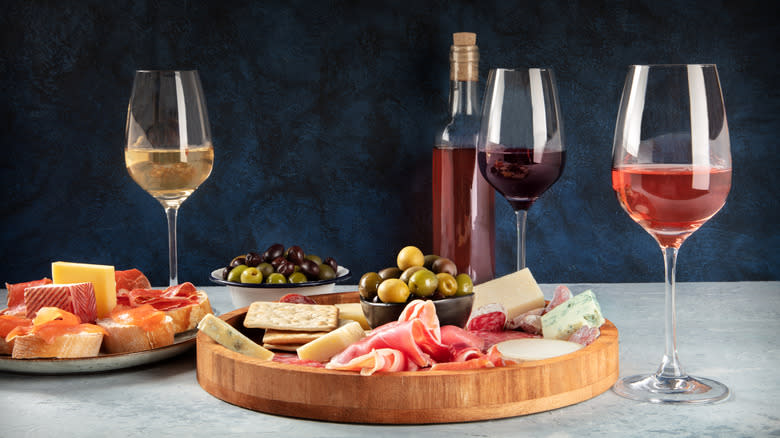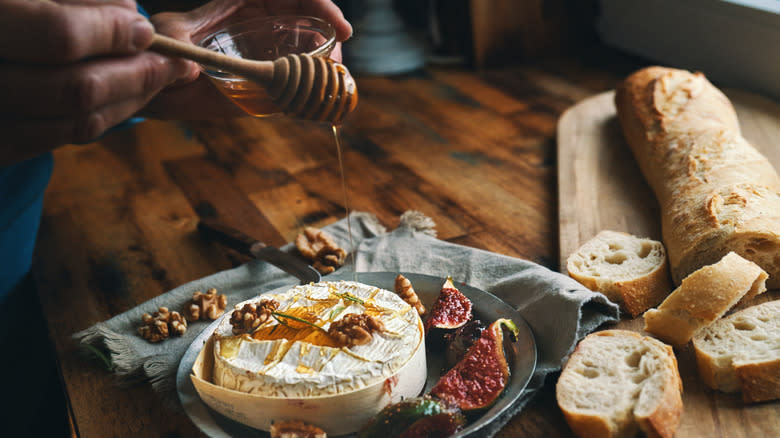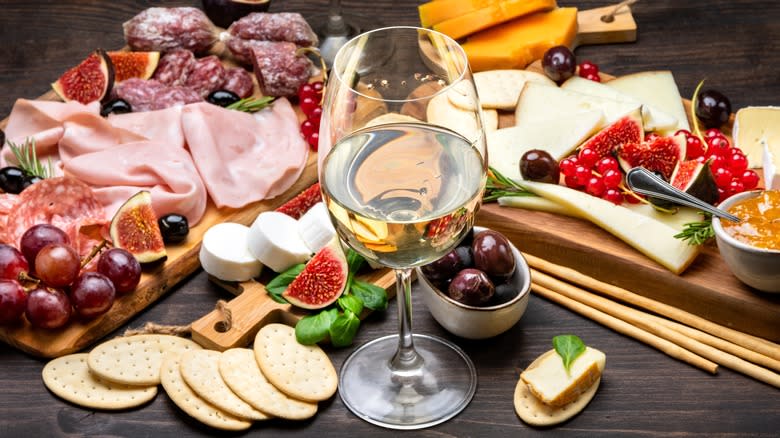What It Means To Find A Flavor Bridge When Pairing Cheese

Building the perfect charcuterie board is all about including different kinds of cheeses and ingredients that take the eater on a journey through varying textures and tastes. Serve aged cheeses alongside sweet, gooey jam for a savory-sweet, hard-meets-smooth combo. Or serve a soft, fresh cheese with cured meat, like a dried salami. Maybe you're already hooked on cheese pairings and love brainstorming intentional ingredients to purchase and serve alongside your favorite cheeses. But what do you do when you run out of go-to pairing ideas?
You can go beyond the basic cheese pairing rules of opposites attracting or finding complimentary flavors. Instead of considering how cheese and another food or drink could contrast or complement each other, find a flavor bridge to close the gap between them. A flavor bridge is essentially a third ingredient thrown into the mix that helps intermingle the elements of your two main pairings, sometimes creating a new flavor experience entirely. In fact, if you've built a charcuterie board before, you've likely already unintentionally created flavor bridges.
Read more: French Cooking Tricks You Need In Your Life
Popular Choices For Cheese Flavor Bridges

No beginner-friendly charcuterie board is complete without a small pot of honey to anchor the board. Honey is a commonly used flavor bridge, as its sweetness perfectly underscores a variety of flavors, from salty, savory cured meats to delicate or aged cheeses, creamy and hard alike. The food science behind it all involves connecting flavor compounds across ingredients. There will be certain ingredients that are likely to share flavor compounds with many other ingredients and some that won't share many at all. Focus on the ingredients with many shared compounds: They're your bridges!
But your flavor bridge doesn't have to be a separate food item. It can be as simple as a delicate seasoning. Lemon zest is a great choice of garnish for fresh cheeses, especially if you're looking to pair the cheese with a white, citrus-coded wine. The idea here is that the lemon zest and white wine with citrus notes will naturally connect with their shared citrus flavors, so the fresh cheese is, therefore, now connected to the wine. Other unlikely spices and seasonings can become brilliant flavor bridges as well, especially when they help you connect entire meals to your cheese appetizer. Or the cheese can be the bridge itself -- the richer, savory flavor bridge between, say, a plain leafy green salad and a light bottle of sauvignon blanc. Sprinkle some feta on top of the salad, and your bridge has been built.
How To Discover Flavor Bridges For Yourself

The key to discovering the right flavor bridge between two seemingly incongruous foods is to add an ingredient that shares flavor compounds with both. Say you don't have one of the best accompaniments to serve with brie on hand, but you want to serve it alongside steak. Both brie and steak can be served topped with caramelized onions. Add those delicately sweet onions into the mix, and suddenly, you have a brie and steak sandwich with caramelized onions that work beautifully.
Flavor bridges are also the perfect tool for diving into the waters of cheese and alcohol pairings. For wine in particular, flavor bridges are your secret weapon for figuring out how oddball pairings like a briny cheese and a fruity wine will make sense together. When pairing cheese and wine, it's not really about avoiding two ingredients with differing flavors. Flavor bridges can fix that. Rather, you should pay attention to how strong or weak the ingredients are compared to one another. For example, a strong, stinky cheese will need an equally strong wine to hold up to it, like a full-bodied pinot noir. Think beyond wine, too, as you can deliciously pair cheese with gin or another alcohol of your choice. Begin to experiment with how to enhance the existing flavor of your two ingredients or connect their contrasting characteristics with flavor bridges. Your cheese pairing game will reach a whole new level.
Read the original article on Daily Meal

